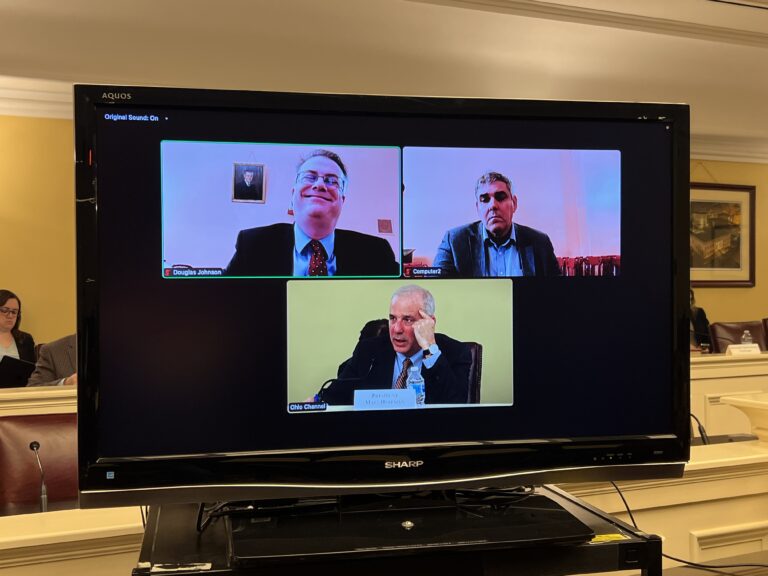In last minute maneuver, redistricting commission votes 4-3 to pass mildly tweaked version of previously rejected maps
BY SUSAN TEBBEN
In a 4-3 decision, Republican members of the Ohio Redistricting Commission voted Monday night to pass slightly changed versions of Statehouse district maps previously rejected by the Ohio Supreme Court as unconstitutional.
In doing so, they abandoned independent mapmakers they had hired.
Commissioners said they did this to fulfill their obligation to send a map to the Secretary of State’s Office and the supreme court by the end of the night.
In the court’s previous rejection, it introduced the idea of using independent mapmakers and objected to the partisan process that had been playing out in previous attempts of Republicans drawing and passing maps to their benefit. The court also asked for “entirely new” maps.

(Photo: Susan Tebben, OCJ)
The maps were first passed in February on a 4-3 vote, with Auditor Keith Faber representing the only GOP “no” vote. They were rejected by the court in mid-March.
That 4-3 vote was maintained along the same lines this time, and Faber wasn’t wholly confident the court would see the map the same way the GOP did.
“I think that there’s a decent chance that this map won’t meet the court’s test,” Faber told reporters Monday night.
Senate President Matt Huffman brought up the revised maps Monday evening, as Dr. Douglas Johnson presented an update on the independent mapmakers progress. He did so, expressing doubts that the mapmakers could get the process done in time.
“The reason is we had essentially 12 days to hire experts, get them in, for them to understand the rules, work with the staff and all of that,” Huffman said.
The maps show a 54-45 GOP advantage in the House and an 18-15 lead in the Senate, but 17 of the Democratic House districts and seven Senate districts are considered political “toss-ups,” meaning they are within two percentage points in partisan breakdown.
In the original maps, 19 House districts fell under that range, but the Senate breakdown was the same, with seven Senate districts as “toss-ups.”
When asked about the slight changes to the maps, House Speaker and commission co-chair Bob Cupp said “it comes closer” to what the court was asking for.
When asked about it by reporters on Monday, Huffman confirmed that the supreme court had said they wanted new maps, rather than old maps with a new look, but said the “parachute” proposal was necessary to get the court maps before the deadline.
The last legislative maps were passed one week after the deadline, as commissioners said they were at an impasse, and couldn’t come to any agreement.
In the process of passing the revised map on Monday, the GOP members also bypassed independent mapmakers’ proposals for House and Senate maps. READ MORE
***
Also from Ohio Capital Journal:

Senate Democratic hopefuls face off in debate over Ukraine, Supreme Court
Rep. Tim Ryan, a current congressman and likely front-runner, fended off attacks throughout the debate from Morgan Harper, a progressive lawyer formerly with the U.S. Consumer Financial Protection Bureau. Traci “TJ” Johnson, a former civil servant and business owner, generally avoided the fray as the three shared the stage for the first time.
The debate, moderated by Spectrum News anchor Curtis Jackson, illuminated splits between the candidates, two of whom were largely unknown to Ohio voters before the primary. For instance, Ryan said he’d be willing to support deploying U.S. troops to Ukraine to defend the country against the Russian invasion. He said concerns about escalation, even via less drastic measures like declaring a no-fly zone over Ukraine, seem to ignore the ongoing destruction of hospitals, schools, and civilian targets in Ukraine.
“I don’t believe the U.S. can stand by and not at least provide these folks with some air support,” he said.
Harper signaled more hesitancy on the matter, saying she’d consider intervention if it came to it. Citing the shoddy intelligence that led to a U.S. invasion of Iraq, however, she called for a need to be “clearheaded” before approving any foreign deployment.
She also called for adding new seats on the U.S. Supreme Court bench, up from the nine that have been in play since 1869. She characterized the court as “radicalized” by Republicans, with the targeting of a woman’s right to receive an abortion via Roe v. Wadeas a clear example.
Ryan said he opposed the idea of adding more justices, as did Johnson who called for Democrats to “tread lightly” given the chance Republicans respond with tit-for-tat increases to the bench. READ MORE

Three takeaways from Ohio Republican Senate debate
In Wilberforce Monday night, all seven of the Republicans vying to replace outgoing U.S. Senator Rob Portman met in a testy but civil debate. Central State University hosted the event, which marked the fourth time in a week and a half that the candidates faced off.
With so many meetings in such a short span, the candidates’ positions on a number of major issues are well established. For the most part, Monday saw the candidates reiterating those points rather than adding nuance or covering new ground. But over the course of the 90-minute debate, a few key themes emerged.
Kill the messenger
Moderator Karen Kasler opened the debate by pressing the candidates to cite “specific verifiable facts” to support their assertions the 2020 election was stolen. Instead, they offered up examples that have been debunked or that have only tenuous connection to the election. Kasler stepped in, to fact check their false statements, and by the second time, her intervention was met with a chorus of boos. READ MORE





